“Employer branding is the image of your organization as a ‘great place to work’ in the mind of current employees and key stakeholders in the external market (active and passive candidates, clients, customers, and other key stakeholders.”
-Brett Minchington, CEO of Employer Brand International
What is Employer Branding?
In very basic terms, your company’s employer brand is your reputation as a place of work and how your employees view you as an employer.
Thus, your employer brand depends on how you market yourself to your employees and potential candidates. The better you are at employer branding, the better people your company will be able to attract. Also, good employer branding will help you retain good talent.
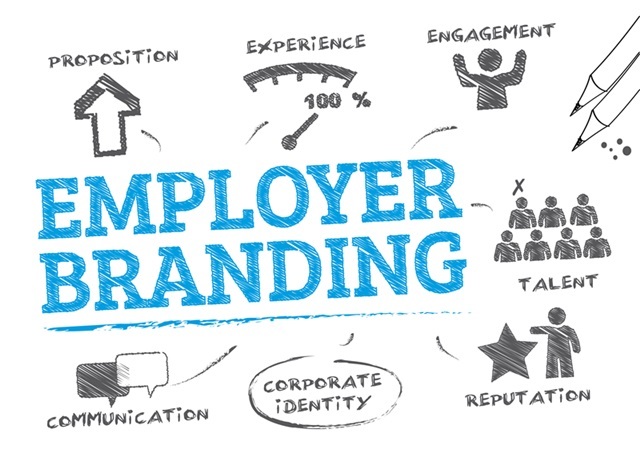
Employer branding. Chart with keywords and icons
Customer brand propositions define Products or services; similarly, an employer value proposition (EVP) defines your company’s employment offering. A well-designed EVP offers the following benefits:
- attracts and retains the best talent
- helps prioritize goals and agendas, especially in workforce planning and HR
- re-engages a dispassionate workforce
- reduces hiring costs
LinkedIn found that 72% of recruiting leaders worldwide agree that employer brand has a significant impact on hiring.
Why is Employer Branding Important?
Consider the following scenario:
Your friend, who is looking for a job, asks, “What is it like to work at your company?”
You aren’t going to say, “Did you know that we were the first to build so-and-so technology?”
Most probably, you will say something like, “It’s great working with my boss. She does not micromanage and is open to hearing my ideas on important presentations. I also have some flexibility with respect to work hours, so I get to spend more time with my child—and it isn’t necessary to drop in at the office every day.”
To ensure that an employee’s answer is something like this, employers have to ensure that they walk the talk. Candidates are three times more likely to trust a company’s employees than the company itself to provide credible information about what it’s like to work there.
Google is an apt example. The company’s offering is a search engine. Even though Google’s search engine is synonymous with “search,” when people talk about the company, they usually don’t talk about its product—they talk about how good it is to work there.
A consistent employer branding strategy needs to be implemented when communicating the company’s culture, values, and leadership. Friday casuals and ping pong tables are not enough to convince people that your company is a great place to work.
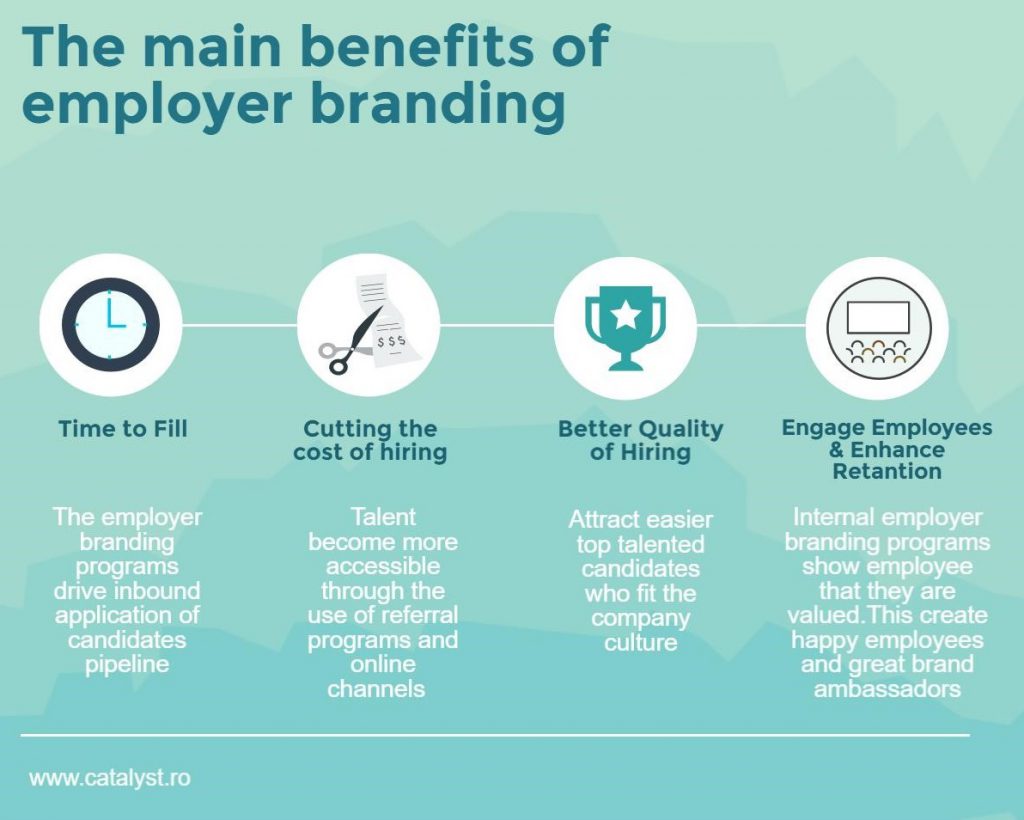
If you still think having an employer branding strategy is not necessary, here are some figures. When a company has a good employer brand,
- candidates who apply are 50% more qualified.
- cost-per-hire is reduced by 50%
- turnover rates are reduced by 28%
- time-to-hire is improved by 1-2 times
How to Build an Efficient Employee Brand?
The ultimate aim of employer branding is to achieve a higher number of qualified applicants, improve employee satisfaction, reduce the time taken to fill roles, and reduce employee turnover.
1. Company values
For successful talent acquisition, a company should shape its core values around its employees. To ensure a positive candidate experience and employee retention, the following actions should be taken:
- Define an EVP that communicates mutual offers and addresses the needs of the individual and the company.
- Create an employer brand that shows candidates why they should work at the company and addresses their needs and desires. This will attract people who have the hard skills to match the job role and the soft skills to match the company culture.
Create a clear and authentic message for your employer brand, so that candidates know exactly what to expect from you.
Some goals that every company should strive for:
- Differentiate the company from its competitors
- Secure long-term recruitment needs
- Establish the employer brand on a local level
- Grow the employer brand to a global scale
2. Employee feedback
Survey current employees using tools like Google forms and use these perspectives to create a compelling narrative for your company. Great storytelling goes a long way in recruiting to attract potential talent and sell the opportunities the company has to offer.
When gathering feedback, ask questions that distinguish your company from the competition. Such polls will help you measure the pulse of the company’s reputation and the attractiveness of the business. This data helps establish metrics and develop a strategy to improve employer branding in recruitment.
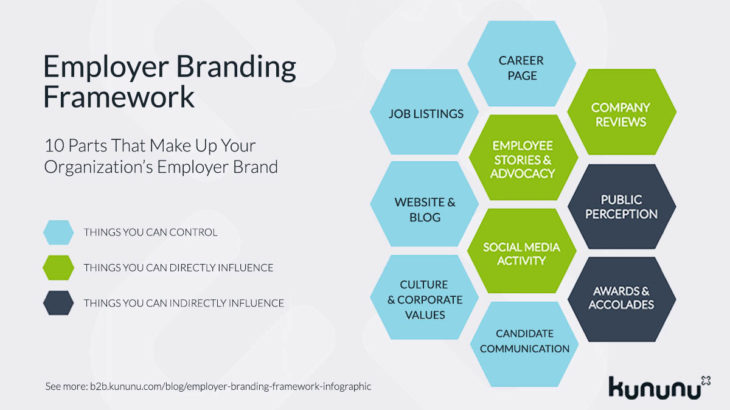
3. Reviews & Testimonials
Career sites like Glassdoor display employee reviews and testimonials, which are potent weapons for good employer branding. Employers must track these testimonials and use the derived insights to build and refine their brand. Glowing testimonials boost credibility and make the company more attractive to potential candidates.
Company profiles should host employee narratives to increase brand awareness and inform candidates about the company’s EVP. Employers should encourage sharing their stories on relevant job boards. Thus, they become effective brand ambassadors for the company.
4. Social media
Your employees are your biggest advocates. Amplify their voice by allowing them some freedom to share their narratives with their networks on social media. Devise ways to use posts from employees on enterprise social networks and career social channels.
Platforms like Twitter, Facebook, Glassdoor, and Instagram should be harnessed to project a cohesive image of the company. Potential talent can be engaged by regularly updating company profiles on social media. Use storytelling to share real stories of real employees instead of clichéd narratives. This will increase the probability of the right-fit talent entering the top of the recruitment funnel.
Employer Branding and Conversion Rate
Efficient employer branding requires persistent efforts as well as tracking and measuring returns on employer brand investment. While there is no universal one-size-fits-all employer branding metrics that every company should measure, tracking funnel conversion rates is useful to determine whether your hiring process is living up to the way in which your branding is selling the opportunity.
Your company’s conversion rate of applicants to full-time hires helps you evaluate if your employer branding strategy is on the right course. Companies with strong employer brands have a higher conversion rate because people come flocking to them—they don’t need to spend time identifying, and engaging potential talent. Some candidates are even willing to accept a lower package if the employer brand is well-known, has positive reviews, and has a good reputation.
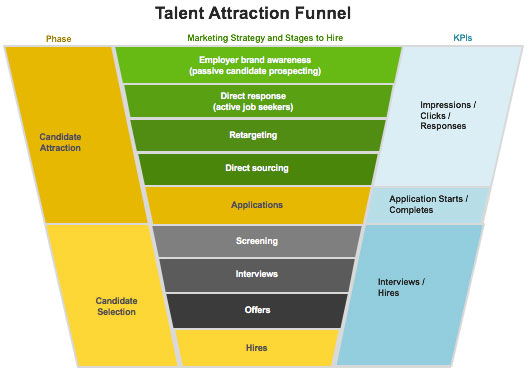
A low conversion rate could mean that there is a weakness somewhere along the hiring funnel, and it needs to be identified and rectified. Using suitable applicant tracking systems and candidate relationship management software can speed up the conversion from candidate to employee.
A Jobvite survey found that the recruiting benchmarks most commonly used by recruiters to assess their performance are: Offers accepted conversion (89%), Interview to offer conversion (17%), and application to interview conversion (12%).
Fat Paycheck vs. Company Culture
New research by the Global Alliance in Management Education (CEMS) indicated that salary is the top criterion that job seekers look for in a new role, followed by work-life balance, opportunities for quick career progression, the chance to make an impact early on, opportunities for global travel, and inspirational leadership.
• Raytheon, a defense company, offers benefits like telecommuting, paid time off, flexible scheduling, parental leave, and other work-life benefits.
• Deloitte has a robust mentoring system, wherein mentors guide their protegees for two years through an intensive learning program and offer one-on-one coaching to develop leadership skills.
Randstad’s Employer Brand Research Global Report 2018 found that candidates ranked “salary & benefits” as one of the top reasons to choose an employer.
• For 18-24-year-olds, factors like career progression, a very good reputation, good training, diversity & inclusion, and giving back to society are important.
• For employees over 45 years of age, an employer’s financial health and job security are more important.
On the longer term, drivers of employer branding that are slowly gaining importance are: flexible arrangements, diversity & inclusion, and giving back to society.
On the longer term, drivers of employer branding that are slowly gaining importance are: flexible arrangements, diversity & inclusion, and giving back to society.
Ways to Improve Employer Branding
The top three channels through which small to mid-sized businesses intend to extend their employer brand are company website (69%), online professional networks (61%), and social media (47%).
Four effective ways to improve your company’s employer brand are:
1. Make optimum use of social media.
Social media has grown to become an essential recruiting channel—79% of job applicants use various platforms during their job search.
You must share relevant company information and engage with potential candidates. Updates, photos, and videos about the company’s events and milestones helps job seekers to get a sense of the company culture. Employee testimonials, CSR initiatives, and staff accomplishments show that the company values its employees.
In fact, 9 out of 10 candidates are likely to apply for a job when it is from an employer brand that is actively maintained.
• Microsoft has a Facebook career page called Microsoft Life, wherein it posts live interviews with its recruiters who answer questions from potential candidates. This is a good way for a company to communicate with potential candidates.
• The Hershey Company hosts information about the organization, its brands, products and services, and job opportunities on its Linkedin page. The page is a great example of employer branding. It is updated with the latest industry trends, with comments from experts.
2. Cultivate a desirable company culture
Company culture reflects in everything—office layout, work-life balance, management style, dress code, employee appreciation perks, competitive benefits.
When making a decision about where to work, 84% of job seekers consider the reputation of the company as an employer important. A company with a bad reputation has much lower chances of attracting new recruits, even if the recruits are desperately looking for a job.
You can determine the strength of your company culture by soliciting feedback from your employees. When employees feel valued, it translates to positive reviews on Glassdoor, which further boosts your brand.
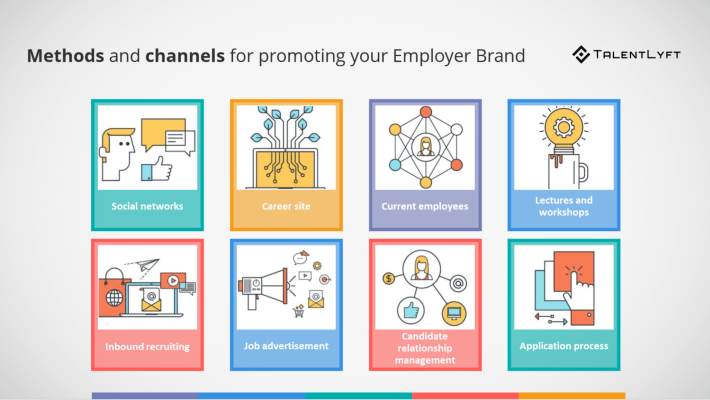
3. Focus on the candidate experience.
A company’s hiring process often determines the volume and quality of applicants. A career page is a good opportunity for you to stand out amongst other employers. If you offer an organized and quick online application experience, candidates will feel that you value their time.
78% of job candidates feel that the overall candidate experience they get is an indicator of how a company values its employees.
Poorly-designed pages, slow loading, a lengthy application process that asks for unnecessary details, requiring labor-intensive work samples—all of these are factors that will put off applicants quickly.
4. Create a referral program.
With a referral program, you win twice. Once, when a candidate gets hired with the minimal recruiting effort. Secondly, when the employee who referred the new hire gets a referral bonus—and boosts your employee brand. If you incentivize employees to recruit for the company, you also motivate them to speak positively about you.
Measure Your Employer Branding Results
Just like marketers test and measure the success of their campaigns, recruiters must measure the results of their employer branding strategies. The following metrics can help:
- Reviews and ratings: Company reviews on Glassdoor are important because candidates check them to evaluate your employer brand. You should track your ratings and identify problem spots to work on.
- Source-of-hire: To determine where your top hires are coming from and focus your efforts, you must track the channels from where candidates are applying.
- Retention rate: Studies suggest that retention rate may be a key indicator of the strength of your employer brand.
- Employer satisfaction: Administer anonymous surveys to get honest feedback from your employees about their level of satisfaction with the company.
Takeaways
Employer branding in recruitment has moved from being an emerging and leading-edge strategy to one that is now adopted by small and large companies across various industries. The volume of internal Employer Brand leadership functions is doubled. It signals to the fact that employer branding is not a temporary fad. People are hoping that employer branding will not just be applied to external recruitment marketing programs, but also to internal culture, employee experience, and communications. This will necessitate more change management and culture alignment.





